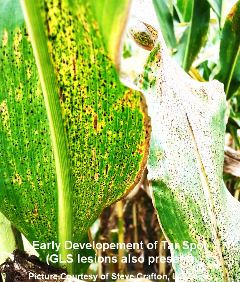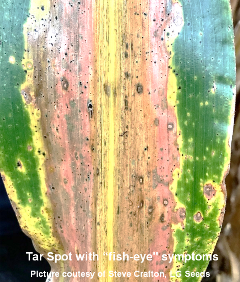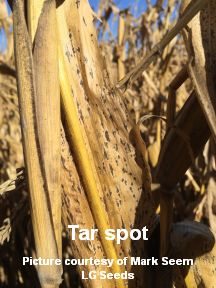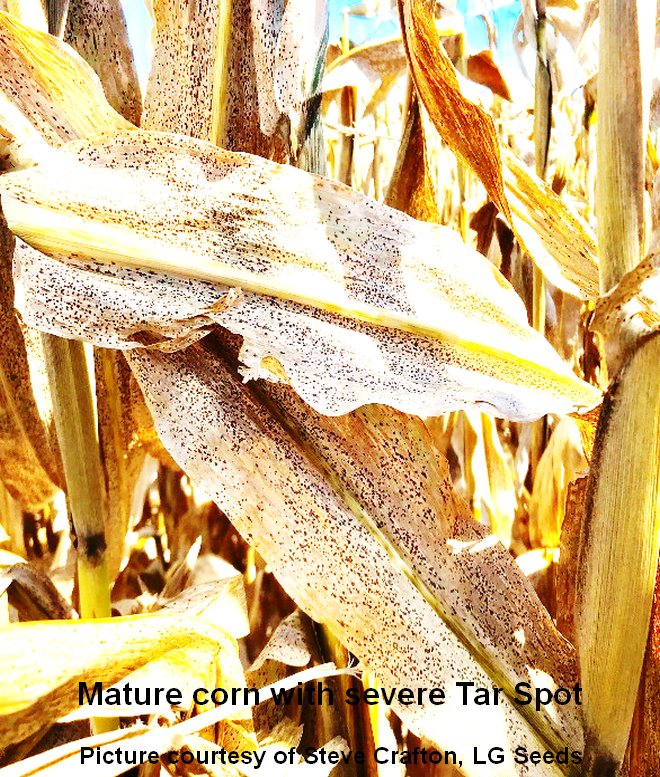AGRONOMIC RESOURCESTO SUPPORT EVERY SEASON
YOU CAN TAKETO THE FIELD
Tar Spot in Corn
Tar spot is caused by the fungus Phyllachora maydis. It’s becoming a widespread issue across Northern Illinois, Northern Indiana and Wisconsin. Universities in each of these states are trying to evaluate and come up with some best management practices on how to combat this disease. Fellow LG Seeds agronomists and I have been scouting plots and trying to come up with some answers as well. We are all in the “research phase” of this new disease and I will try to sum up what we know to date.
Tar spot was first diagnosed in a few counties in Northern Illinois and Northern Indiana in 2015. It is believed that wind-driven storms from Mexico distributed spores into those counties. The disease overwinters in soil debris and spores can be distributed further by storms. Tar spot is favored in cool conditions with high humidity. Tar spot symptoms on the corn leaves are round raised black spots that feel “bumpy” when you touch them. Tar spot alone is mainly a “cosmetic” disease with little known yield loss. In Latin America, combinations of Phyllachora maydis along with Monographella maydis and or Coniothyrium phyllahorae organisms have led to significant yield losses. But these combinations have not been found in the Midwest. Some feel that it’s a combination of Phyllachora maydis and another “unknown” organism that is causing the same symptoms in the Midwest as in Latin America. “Fish-eye” is a visual characteristic of the combination of the two organisms which can lead to severe leaf necrosis, stalk quality and a greater potential of yield loss.


I, along with other agronomists on our team, have been scouting fields in Illinois and Wisconsin trying to come up with correlations on best management tips to combat this new disease. There does seem to be some genetic tolerance to tar spot, but a “silver bullet” has not been found yet. We also believe that fertility, rotation and fungicides play a big role in severity of infection. In combinations of tar spot and grey leaf spot or various stalk rots, the disease intensifies. This intensification leads to severe leaf and stalk necrosis, and can hinder kernel fill if the plant is infected early. Universities are working on analyzing test plots with various fungicides applications and timing. Fields with heavy infections of this disease need to be pushed to the front of the harvest line because standability could be an issue.


Tar spot is a new disease with a lot of “unknowns” on best management practices. There will be a learning curve the next few years, but there are some management practices that will help combat this new disease. Keeping that plant happy and healthy as long into the season as we can will help fend off severe infection. Crop rotation, healthy hybrids, fungicides, and a good fertility program with late season nitrogen application should all help to prevent severe infections of tar spot. We have seen cases of the same hybrid planted on rotated ground, good fertility and management with hardly any tar spot, and five miles down the road the same hybrid suffering from poor fertility and corn-after-corn with severe tar spot infection. If you have a field with severe tar spot infection I would advise to push it to the top of the harvest schedule. A strong wind storm could cause severe lodging in a lot of these fields.
If you have further questions about tar spot, be sure to talk with your LG Seeds Technical Team Agronomist.
Resources and additional information:
https://badgercropdoc.com/2018/08/29/holy-tar-spot-batman/
http://cropdisease.cropsciences.illinois.edu/?p=822
https://www.extension.purdue.edu/extmedia/BP/BP-90-W.pdf
Download a copy of this Technical Bulletin: Tar Spot in Corn






Technical Agronomist